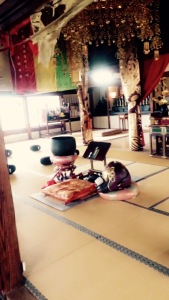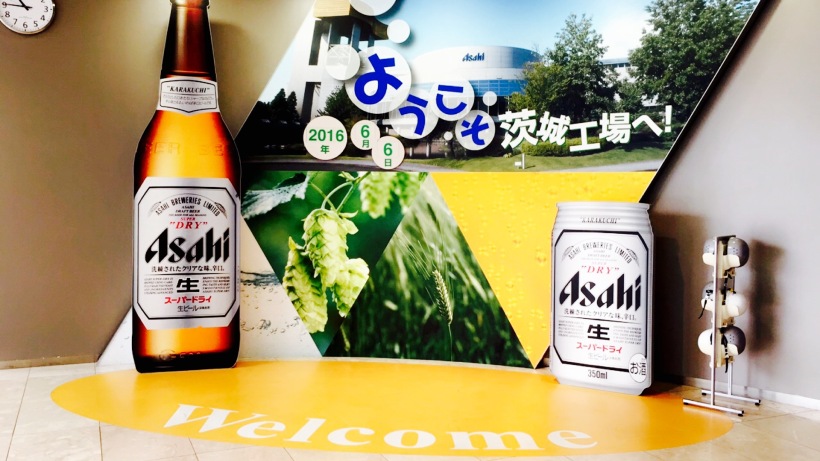Welcome back to our study abroad experience in Japan! Have you ever wondered how soy sauce is made? We took a tour of the Kikkoman Factory to learn all about it! We will be sharing a lot of really cool information about the process with you, as well as covering some of our experience with Zen in meditation and calligraphy.
The first part of our day started with a tour of the Kikkoman factory. We watched a short film that briefly explained the process before going through the factory. There are only four ingredients: water, soybeans, wheat, and salt. A microbe called Koji is added as well in order to ferment the ingredients. This is also referred to as “Kikkoman’s aspergillus.” First the soybeans are steamed and the wheat is roasted. These two ingredients are combined and thoroughly mixed before adding the Koji. The mixture is left to ferment for a few days in a warm environment. At this point, it is mixed with water and set in batches to develop over the course of six months. This mixture is called moromi. After six month’s time, the moromi is coated onto linens that are folded and mashed under a heavy weight to proceed with collecting the soy sauce. Before being bottled, the soy sauce is pasteurized to kill off the Koji. At this point we now have our soy sauce! We were given the opportunity to run through the process and make soy sauce ourselves to coat onto delicious rice crackers! This allowed us to experience the various flavors within soy sauce, such as umami, sweet, and salty. What a tasty experience!
After this, we proceeded to undergo a Zen experience by making our way to a local temple where a priest would guide us into meditation. The outside of the temple was a beautiful Zen garden that had a fountain with which to cleanse your hands and feet. The inside was ornately decorated in gold and red. I had a fair amount on my mind as I walked in, and thus, was very appreciative to be there. We proceeded to sit in half-lotus and get whisked away into trance by the sound of the priest drumming. For a few seconds he  drummed very vigorously and it uncontrollably sent shivers down my spine, preparing me for a supernatural experience. As I breathed in, I tried to envision golden white light pervading my entire being and ridding me of negativity. This relaxed me to such a degree that I felt myself fading into deep sleep. Given that lotus position brings my spine straighter, it was easy to catch myself when this would happen. I would then realign my focus to just breathing again. Between the phases of waking and dozing, I would see very interesting visions that would slip away as soon as I had them. To pull our thirty minute session to a close, the priest began to drum in the same fashion as before, again giving me chills. After this calming activity, we went into another room of the temple to practice calligraphy. Although difficult, this too centered my focus and gave me quite a calm feeling. The sutra that we were copying read that enlightenment does not actually exist. I could not help but to be reminded of the part in The Matrix series when the child tells Neo that “there is no spoon.” The way I translate this is that when you seek to attain something, you are focusing on the lack thereof. If you focus on what you already have that you love, you are expanding upon these energies. Experiences like this always make me feel like I may walk the path properly and without fear. Let us never forget to take a moment to breathe with every step.
drummed very vigorously and it uncontrollably sent shivers down my spine, preparing me for a supernatural experience. As I breathed in, I tried to envision golden white light pervading my entire being and ridding me of negativity. This relaxed me to such a degree that I felt myself fading into deep sleep. Given that lotus position brings my spine straighter, it was easy to catch myself when this would happen. I would then realign my focus to just breathing again. Between the phases of waking and dozing, I would see very interesting visions that would slip away as soon as I had them. To pull our thirty minute session to a close, the priest began to drum in the same fashion as before, again giving me chills. After this calming activity, we went into another room of the temple to practice calligraphy. Although difficult, this too centered my focus and gave me quite a calm feeling. The sutra that we were copying read that enlightenment does not actually exist. I could not help but to be reminded of the part in The Matrix series when the child tells Neo that “there is no spoon.” The way I translate this is that when you seek to attain something, you are focusing on the lack thereof. If you focus on what you already have that you love, you are expanding upon these energies. Experiences like this always make me feel like I may walk the path properly and without fear. Let us never forget to take a moment to breathe with every step.
Japan Study Abroad: Day Seven




 drummed very vigorously and it uncontrollably sent shivers down my spine, preparing me for a supernatural experience. As I breathed in, I tried to envision golden white light pervading my entire being and ridding me of negativity. This relaxed me to such a degree that I felt myself fading into deep sleep. Given that lotus position brings my spine straighter, it was easy to catch myself when this would happen. I would then realign my focus to just breathing again. Between the phases of waking and dozing, I would see very interesting visions that would slip away as soon as I had them. To pull our thirty minute session to a close, the priest began to drum in the same fashion as before, again giving me chills. After this calming activity, we went into another room of the temple to practice calligraphy. Although difficult, this too centered my focus and gave me quite a calm feeling. The sutra that we were copying read that enlightenment does not actually exist. I could not help but to be reminded of the part in The Matrix series when the child tells Neo that “there is no spoon.” The way I translate this is that when you seek to attain something, you are focusing on the lack thereof. If you focus on what you already have that you love, you are expanding upon these energies. Experiences like this always make me feel like I may walk the path properly and without fear. Let us never forget to take a moment to breathe with every step.
drummed very vigorously and it uncontrollably sent shivers down my spine, preparing me for a supernatural experience. As I breathed in, I tried to envision golden white light pervading my entire being and ridding me of negativity. This relaxed me to such a degree that I felt myself fading into deep sleep. Given that lotus position brings my spine straighter, it was easy to catch myself when this would happen. I would then realign my focus to just breathing again. Between the phases of waking and dozing, I would see very interesting visions that would slip away as soon as I had them. To pull our thirty minute session to a close, the priest began to drum in the same fashion as before, again giving me chills. After this calming activity, we went into another room of the temple to practice calligraphy. Although difficult, this too centered my focus and gave me quite a calm feeling. The sutra that we were copying read that enlightenment does not actually exist. I could not help but to be reminded of the part in The Matrix series when the child tells Neo that “there is no spoon.” The way I translate this is that when you seek to attain something, you are focusing on the lack thereof. If you focus on what you already have that you love, you are expanding upon these energies. Experiences like this always make me feel like I may walk the path properly and without fear. Let us never forget to take a moment to breathe with every step.